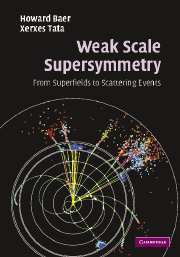Book contents
- Frontmatter
- Contents
- Preface
- 1 The Standard Model
- 2 What lies beyond the Standard Model?
- 3 The Wess–Zumino model
- 4 The supersymmetry algebra
- 5 Superfield formalism
- 6 Supersymmetric gauge theories
- 7 Supersymmetry breaking
- 8 The Minimal Supersymmetric Standard Model
- 9 Implications of the MSSM
- 10 Local supersymmetry
- 11 Realistic supersymmetric models
- 12 Sparticle production at colliders
- 13 Sparticle decays
- 14 Supersymmetric event generation
- 15 The search for supersymmetry at colliders
- 16 R-parity violation
- 17 Epilogue
- Appendix A Sparticle production cross sections
- Appendix B Sparticle decay widths
- Appendix C Higgs boson decay widths
- Bibliography
- Index
2 - What lies beyond the Standard Model?
- Frontmatter
- Contents
- Preface
- 1 The Standard Model
- 2 What lies beyond the Standard Model?
- 3 The Wess–Zumino model
- 4 The supersymmetry algebra
- 5 Superfield formalism
- 6 Supersymmetric gauge theories
- 7 Supersymmetry breaking
- 8 The Minimal Supersymmetric Standard Model
- 9 Implications of the MSSM
- 10 Local supersymmetry
- 11 Realistic supersymmetric models
- 12 Sparticle production at colliders
- 13 Sparticle decays
- 14 Supersymmetric event generation
- 15 The search for supersymmetry at colliders
- 16 R-parity violation
- 17 Epilogue
- Appendix A Sparticle production cross sections
- Appendix B Sparticle decay widths
- Appendix C Higgs boson decay widths
- Bibliography
- Index
Summary
The Standard Model is a consistent, renormalizable quantum field theory that accounts for a wide variety of experimental data over an energy range that encompasses a fraction of an electron volt to about 100 GeV, a range of over twelve orders of magnitude. Initially, the SM was tested at the tree level, but the remarkable agreement between SM predictions and the precision measurements at the CERN LEP collider have tested the SM to at least a part per mille and, more importantly, have established that radiative corrections as given by the SM are essential for agreement with these data. Quite aside from this, the SM also qualitatively explains why baryon and lepton numbers appear to be approximately conserved: with the particle content of the SM, it is not possible to write renormalizable interactions that do not conserve baryon and lepton numbers, so that these interactions (if they exist) must be suppressed by (powers of) some new physics scale.
The SM is nevertheless incomplete. Experimental arguments in support of this are:
E1 The solar and atmospheric neutrino data, interpreted as neutrino oscillations, strongly suggest neutrinos have mass.
E2 Observations, starting with Zwicky in 1933 and continuing to this day with studies of the fluctuations in the spectrum of the relic microwave background from the Big Bang, have established the existence of cold dark matter in the Universe for which there is no candidate in the SM.
E3 Observations of type Ia supernovae at large red shifts as well as the cosmic microwave background radiation both suggest that the bulk of the energy of the Universe resides in a novel form dubbed “dark energy”. This could be the cosmological constant first introduced by Einstein, or something more bizarre.
E4 Gravity exists.
- Type
- Chapter
- Information
- Weak Scale SupersymmetryFrom Superfields to Scattering Events, pp. 11 - 22Publisher: Cambridge University PressPrint publication year: 2006



